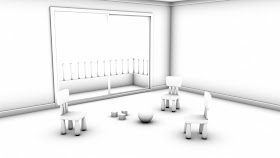 |
| Fig 1. |
"
Kubo and the Two Strings" (2016) dir. Travis Knight, produced by Laika Studios, centering on the titular "Kubo", a young boy who leaves his distant cave (and sickly mother) to go to town and perform for it's folk every day. Events kick off when Kubo stays out late one day in order to attend the villages "Bon Festival" - a festival honouring the dead; disobeying his mothers pleas in the process, which, as it transpires, turns out to be something he should have listened to. At sunset, Kubo is attacked my his mother's ghostly sisters, as she is forced to protect him with her last ounce of magic, sending him to a distant land...and his journey's start.
 |
| Fig 2. |
What makes Kubo so enthralling is it's want to dispense with quickfire editing that seems to be ever present in contemporary children's entertainment. "
There is a lyrical quality to the writing, which is a refreshing alternative to the slapdash slang assault of many family films." (Ide, 2016) Kubo makes a point of making the audience wait, and as such, shot's frequently have that alluring quality that invites the eye to inspect each and every artisinal quality the film offers. And, if anything, that's the qualifier that best suits this film, for everything is truly bespoke. Aided by a myriad of new techniques, making this a tremendously ambitious affair and Laika's (and Travis') "
most ambitious project his company has attempted, pushing the envelope of 3D printing in animation to new levels" (Giardina, 2016). It's such a treat to find a film that truly delivers on what it promises, on all levels including story. And that seems to stem from Travis' somewhat omnipresence on the project. Perhaps the quality of writing stems from that? Travis himself mentions "
I wanted to approach [the subject of death] with sincerity and honesty," says Knight, who suffered his own loss in 2004, when his brother died in a tragic diving accident." (Giardina, 2016) and indeed the fact that this is such a personal overall theme seems to corroborate the immense quality of the film.
 |
| Fig 3. |
Laika's previous films, "
Coraline" (2009), "
ParaNorman" (2012) and "
Boxtrolls" (2014) all carry this quality however, and it really seems as though the studio is going from strength to strength, in fact "
Laika's first film release was 2009's Coraline, which was nominated for an Oscar and grossed $124.6 million worldwide. Its second movie, 2012's ParaNorman, also was Oscar nominated and grossed more than $100 million. Ditto its third, 2014's The Boxtrolls." (Giardina, 2016) And it's really their knack for imbuing their properties with an interesting mix of classic stop motion work (in the vein of Harryhausen) with new techniques that afford them an incredible amount of flexibility in their workflow.
The bespoke design work features incredibly attention to detail. In one sequence, where Kubo and co journey over the "Long Lake" in a ship made of leafs, the design crew mention having
"to map every leaf — thousands of them, each individually laser-cut and about the size of a human thumbnail — and reproduce the exact same pattern on both ships, so they'd match from shot to shot within the film. It's a lot of effort for something most people wouldn't notice. "God knows," Pascall sighs, "there are easier ways to make movies." (Robinson, 2016) But for Laika, and certainly Knight himself, easier ways aren't as worthwhile. It seems even during this projects inception Knight knew what an undertaking it would be. Knight,
" A sucker for fantasy and a fan of Japanese culture" (Giardina, 2016) admits that "
I bit off more than I could chew" (Giardina, 2016) though this isn't a problem. With critics and audiences alike serving as proof that the gamble paid off.
The distinct flavour possessed here isn't wholly 'of' any particular culture, although the film's director was a self confessed fan of Japanese culture, and the story presents a melancholic and mature take on the themes of loss and acceptance that evoke the complexity and maturity on display in Studio Ghibli animations. This represents a heady mix of Japanese influences and American sensibility, though it's sensitivity and patience can definitely be ascribed to the works of Ghibli.
 |
| Fig 4. |
"
Kubo and the Two Strings" is a rare treat. One that is distinct and measurable based on the sheer effort poured into it. The techniques on display here coupled with attention to detail make this feature an industry benchmark, throwing up grand notions of Laika stepping up to become this generations 'Pixar'. Whatever happens from here on, the audience wins.
Bibliography
Giardina, Carolyn. (2016) "
How 'Kubo and the Two Strings' Merged Stop-Motion Animation and 3D Printing (Plus a 400-Pound Puppet)" hollywoodreporter.com At: http://www.hollywoodreporter.com/features/how-kubo-two-strings-merged-stop-motion-animation-3d-printing-a-400-pound-puppet-955406 (Accessed 20/05/17)
Ide, Wendy. (2016) "
Kubo and the Two Strings review – lyrical stop-motion tale" theguardian.com At: https://www.theguardian.com/film/2016/sep/11/kubo-and-two-strings-review (Accessed 20/05/17)
Robinson, Tasha. (2016) "
Inside Laika studios, where stop-motion animation goes high tech" theverge.com At: https://www.theverge.com/2016/8/18/12500814/laika-studios-behind-the-scenes-kubo-and-the-two-strings-video (Accessed 20/05/17)
Illustrations
Fig 1. Kubo Poster. [image] At: http://cdn.collider.com/wp-content/uploads/2016/04/kubo-and-the-two-strings-poster-the-far-lands.jpg (Accessed 20/05/17)
Fig 2. Kubo and Monkey. [image] At: http://www.beliefnet.com/columnists/moviemom/files/2016/08/kubo-and-monkey.jpg (Accessed 20/05/17)
Fig 3. The Sisters. [image] At: http://www.indiewire.com/wp-content/uploads/2016/08/kubo-the-sisters.jpg?w=780 (Accessed 20/05/17)
Fig 4. Kubo with wings. [image] At: http://www.rotoscopers.com/wp-content/uploads/2016/03/FB_IMG_1457541105678.jpg (Accessed 20/05/17)




































